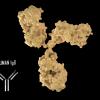Nanobotmodels medical animation studio launches branch of molecular biology education videos. First issue - mechanism of prion diseases in action.
Creutzfeldt-Jakob disease (CJD) is a degenerative brain disorder caused by misshapen brain proteins. In the early stages, symptoms often appear similar to those of other dementias, making CJD hard to diagnose. Although a rare disease, it affects approximately one in one million people worldwide and invariably proves fatal.
One type of prion disease in humans, variant Creutzfeldt-Jakob disease (vCJD), is acquired by eating beef products obtained from cattle with prion disease. In cows, this form of the disease is known as bovine spongiform encephalopathy (BSE) or, more commonly, “mad cow” disease. Another example of an acquired human prion disease is kuru, which was identified in the South Fore tribe in Papua New Guinea. The disorder was transmitted when tribe members ate the tissue of affected people during cannibalistic funeral rituals.
A prion in the Scrapie form (PrPSc) is an infectious agent composed of protein in a misfolded form. And it may lead to CJD appear. Abnormal prions cause neurodegenerative disease by aggregating extracellularly within the central nervous system to form plaques known as amyloid, which disrupt the normal tissue structure. This disruption is characterized by “holes” in the tissue with resultant spongy architecture due to the vacuole formation in the neurons. Other histological changes include astrogliosis and the absence of an inflammatory reaction. While the incubation period for prion diseases is relatively long (5 to 20 years), once symptoms appear the disease progresses rapidly, leading to brain damage and death. Neurodegenerative symptoms can include convulsions, dementia, ataxia (balance and coordination dysfunction), and behavioural or personality changes.
Nanobotmodels medical animation studio used most sophisticated molecular software to display prion transformation processes and prion distribution and aggregation in action. First of all - thanks to ePMV and autoPACK plugin, developed by Graham Jonson.
cellPack (http://www.autopack.org/) is a specialized version of autoPack designed to pack biological components together. The current version is optimized to pack molecules into cells with biologically relevant interactions to populate massive cell models with atomic or near-atomic details. Components of the algorithm pack transmembrane proteins and lipids into bilayers, globular molecules into compartments defined by the bilayers (or as exteriors), and fibrous components like microtubules, actin, and DNA.
Nanobotmodels (http://nanobotmodels.com) was established in 2007 with the goal of developing highly innovative, digital graphics to depict actual and conceptual technologies via the synergistic fusion of art and science. The still nascent, yet prospectively powerful discipline of nanotechnology is poised to radically transform medicine, engineering, biotechnology, electronics and myriad other sectors in the relative near-term. Hence, visionary artistic renderings that portray various aspects of this exciting nanofuture will be beneficial in facilitating a clear understanding of its fundamental concepts to a broad demographic.
Nanobotmodels generates imaginative and engaging state-of-the-art nanotechnology and nanomedical illustrations and animations. Any prototypical component, device, system or far flung concept that might be conceived of can be translated into captivating and colorful photorealistic animated or static renderings and presentation materials…. We bring them all to life for you!
For all questions about animation feel free to connect Svidinenko Yuriy - tinraaa(at)gmail.com




